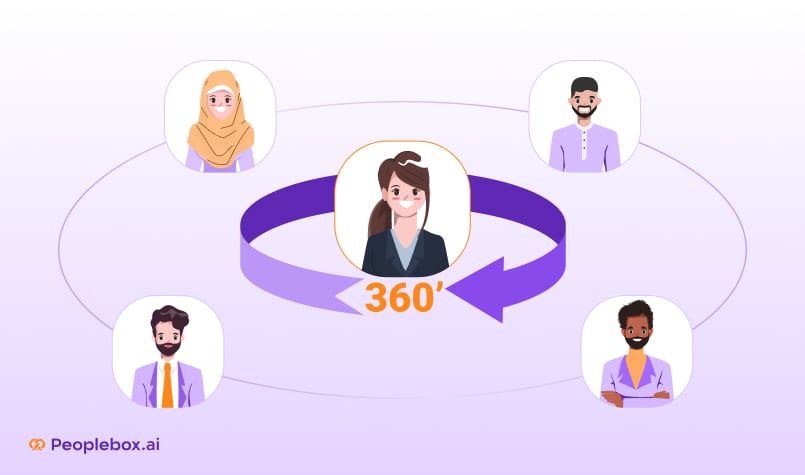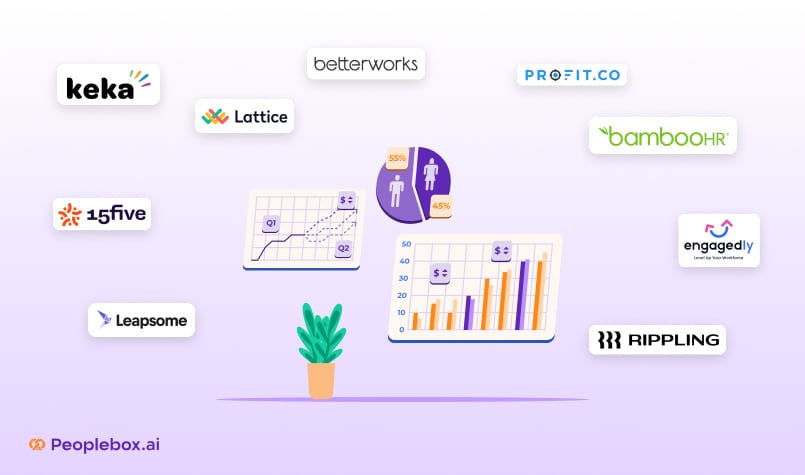Development at work is one of the key factors that fulfill a person’s drive for work and social well-being. Career growth opportunities are the number one reason people switch jobs.
This means that if your employees don’t find growth opportunities within your organization, they will seek them elsewhere. The best way to retain them is through a structured employee growth plan.
An employee growth plan helps employees improve their skills while staying within your organization. Thus, you can maintain a trained workforce that works towards your organization’s growth.
In this blog, we discuss how to create an employee growth plan that benefits both you and your employees.
Let’s dive in.
What is an Employee Growth Plan?
An employee growth plan is a structured framework designed to help employees with their professional development within your organization.
It focuses on helping employees acquire new skills and improve existing ones to advance their careers. The plan also aligns employee personal goals with the company’s strategic objectives.
These plans are typically customized to each individual, ensuring the development path is relevant to their current role and future aspirations.
Key elements of an employee growth plan:
- Skill development: Identifies specific skills or competencies an employee needs to develop to advance in their role or prepare for future positions. This might include hard skills (technical abilities) and soft skills (communication or leadership).
- Career goals: Outlines short-term and long-term career goals that align with the employee’s aspirations, providing a roadmap for progression.
- Action plan: Details the activities, resources, and timelines required to achieve these goals. It may include formal training programs, mentorship, job rotations, or on-the-job learning opportunities.
- Regular feedback and evaluation: Involves scheduled check-ins between the employee and their manager to review progress, provide feedback, and make adjustments to the plan as needed.
What are the Types of Employee Growth Plans?
Here are some types of employee growth plans that you can try based on your requirements:
Career development plans
- Focus on long-term career paths within the company.
- Include skills mapping, training, mentorship, and opportunities for advancement.
| 📚Ideal for: Employees who want to see a clear trajectory for their professional growth. |
Performance Improvement Plans (PIP)
- Address specific performance gaps.
- Structured with short-term goals, regular check-ins, and targeted training.
| 📚Ideal for: Employees needing support to reach performance standards. To implement PIP, you can use the performance management software by Peoplebox. It comes with 360-degree reviews, 1:1s, and check-ins that you can use to review employee performance and personally connect with them to check progress. |
Skill development plans
- Aim to develop new or enhance existing skills.
- Include workshops, online courses, and cross-training opportunities.
| 📚Ideal for: Useful for employees whose role requires them to be updated with industry trends. |
Leadership development plans
- Focus on preparing high-potential employees for leadership roles.
- Include leadership coaching, stretch assignments, and rotational programs.
| 📚Ideal for: Succession planning and nurturing future managers. |
Job enrichment plans
- Involve broadening an employee’s job role to add more responsibilities or variety.
- Aimed at increasing job satisfaction and providing new challenges.
| 📚Ideal for: Retaining skilled employees who seek more engagement in their current roles. |
What are the Benefits of an Employee Growth Plan?
1. Increased Employee Engagement
Growth opportunities keep employees engaged as they hope for career advancement within the organization. Engaged employees are more committed to their roles, leading to higher productivity.
2. Improved Retention Rates
Organizations who invest in employee development are twice as likely to retain their employees. Active growth opportunities reduces turnover costs as employees know that they can grow within your organization.
3. Enhanced Skill Development
Focused training helps employees adapt to evolving industry trends and technology. For example, training tech employes in AI will ensure they are equipped for future industry changes. This creates a more skilled and versatile workforce.
4. Stronger Leadership Pipeline
When you train your best employees for leadership roles, you ensure that you always have qualified candidates for leadership roles who are aware of your product and company culture. It also prepares employees to take on greater responsibilities within the company.
5. Positive Organizational Culture
A culture of continuous learning attracts top talent and sets a standard for innovation. Employees tend to talk about their learnings on social media which attract fresh talent to your organization and promotes your compay culture.
How Do You Create An Employee Growth Plan?
Step 1: Assess Organizational Needs and Employee Goals
Conduct skills assessments and employee surveys to understand the skill gaps in your organization and the personal growth goals of each employee. This helps you tailor development plans that can benefit employees and the organization.
For example, if data analytics skills are crucial for future projects, find employees who want to learn analytics or want to take on more roles in analytics. Then, train them based on your organizational requirements.
Step 2: Set Clear, Achievable Goals
Define Specific, Measurable, Achievable, Relevant, and Time-bound (SMART) goals that align with both the employee’s career growth and the company’s strategic needs.
For example, a SMART goal for a marketing specialist aiming to improve their digital skills could be: “Complete a Google Analytics certification by the end of the next quarter and apply new skills to increase website traffic by 15%.”.
This goal is:
- specific (certification and traffic increase)
- measurable (15% target)
- achievable (with training support)
- relevant (to marketing needs)
- time-bound (by the end of the quarter)
With such goals, you can create a clear pathway for professional development and measurable success.
Step 3: Identify Development Opportunities
A growth plan works only when you identify opportunities that align with their current skills and career goals. You must understand what they need to learn and offer tailored learning experiences that fit their needs.
For example, consider an HR assistant who wants to become a talent acquisition specialist. To push this assistant closer to her goals, her manager can involve her in the recruitment process for entry-level positions.
This helps her gain hands-on experience in screening resumes and conducting interviews. She can also learn how to use AI resume screening tools to speed up the process.
Additionally, her manager could arrange mentorship sessions with a senior recruiter who can teach her interviewing techniques.
Engaging employees in opportunities like these keeps them engaged. They see that their managers see their potential and are happy to promote them to better positions.
Step 4: Create a Structured Timeline
Develop a timeline with clear milestones and track progress regularly in quarterly reviews and monthly check-ins.
You can create KPIs for employee growth plan so both employees and HRs can keep track of their progress. Peoplebox lets you create a customizable KPI dashboard where you can track objectives, metrics and action items.
For example, you can ask employees to finish two modules and one assessment in a week and track progress here. They can also change these metrics based on their workload and finish training in a timely manner.
Step 5: Provide Ongoing Feedback and Support
Since employees train along with their day-to-day work, it’s important to provide continuous feedback and support. Create a culture of open discussion where employees can freely communicate if they want to change or pause a course.
The best way to motivate employees to share feedback is through anonymous 1:1 conversations. You can set up contextual questions, and employees can answer them anonymously.
Peoplebox helps you manage this effortlessly. You can create an inbox for such feedback and filter responses by department, driver, location, and manager, so no matter how many responses you get, you can always find the ones you need at any point in time.
This saves time and helps you manage feedback and support quickly without compromising on your other tasks.
Step 6: Evaluate and Adjust the Plan
Conduct a comprehensive review at the end of a set period (6-12 months) to evaluate the outcomes against the initial goals. Based on the feedback from managers and employees, you can adjust the plan.
Employee Growth Plan Examples
1. Google: Career Development Framework
Google’s Career Development Framework is designed to promote continuous learning and facilitate career advancement for its employees.
Key Features:
- Googler-to-Googler (G2G) Learning: This unique internal program encourages employees to share their expertise with one another. Employees can teach courses or workshops on various topics, fostering a culture of collaboration and peer learning.
- Diverse Learning Opportunities: Google offers a range of resources, including online courses, mentorship programs, and leadership training, ensuring employees can find the right fit for their development needs.
- Personalized Career Paths: Employees work with their managers to outline clear career paths, setting specific goals aligned with both personal aspirations and organizational objectives.
Actionable Insight for HR:
Implement a peer-to-peer learning program in your organization, similar to Google’s G2G initiative. Encourage employees to share their knowledge through workshops or informal training sessions. This builds a collaborative environment and empowers employees to take ownership of their learning journeys.
2. Microsoft: Growth Mindset Framework
Overview: Microsoft encourages a culture of continuous improvement and skill development.
Key Features:
- Structured Learning Paths: Employees have access to a variety of learning modules and certifications tailored to their roles.
- Regular Development Check-ins: Managers hold periodic one-on-one meetings to discuss employee progress, challenges, and career aspirations.
- Leadership Development Programs: Targeted training for high-potential employees to prepare them for future leadership roles.
Actionable Insight for HR:
- Establish regular check-ins to discuss employee growth and create structured learning paths that provide clear milestones and objectives.
How to Structure an Employee Growth Plan? (Free Template)
You need a well-structured employee growth plan to align individual career aspirations with the broader goals of the organization. It lays a roadmap for both employees and managers that helps you set proper benchmarks and provide ongoing feedback.
Without a clear structure, growth plans can become vague, and it gets hard to engage employees.
Template for structuring an employee growth plan
Based on a synthesis of various templates from trusted HR resources, here is an effective structure that HR professionals can use to create a tailored employee growth plan:
| Employee information | Details: Include the employee’s name, position, department, and managerPurpose: Sets the context for the plan and ensures clarity about who is involved |
| Self-assessment and skills inventory | 1. Self-Reflection: Encourage employees to reflect on their strengths, areas for improvement, and their most satisfying job aspects 2. Skills Inventory: Assess current skills using a skills matrix, comparing existing competencies with those required for their desired role 3. Purpose: Identifies gaps and helps target areas for development |
| Development goals | 1. Short-term goals: Specific goals to be achieved within 3-6 months (e.g., mastering a new software tool) 2. Mid-term goals: Objectives that align with upcoming organizational needs (6-12 months) 3. Long-term goals: Career aspirations for 1+ years, such as advancing to a managerial position 4. Purpose: Provides a clear direction and timeline for development, ensuring goals are SMART (Specific, Measurable, Achievable, Relevant, Time-bound) |
| Action plan | 1. Learning activities: Include a mix of methods like online courses, workshops, job shadowing, or mentorship opportunities 2. 70-20-10 approach: Structure activities as 70% on-the-job experiences, 20% coaching/mentorship, and 10% formal training 3. Resources needed: Detail any resources like tuition reimbursement, access to online learning platforms, or time allocations for training 4. Purpose: Defines how the employee will achieve their goals with a focus on varied and engaging learning methods. |
| Support and feedback mechanisms | 1. Manager’s role: Outline how managers will support the employee (e.g., monthly check-ins, providing mentorship) 2. Feedback sessions: Schedule regular feedback opportunities (e.g., monthly or quarterly reviews) to discuss progress challenges, and adjust the plan if needed 3. Purpose: Ensures continuous alignment and provides motivation through regular recognition and course correction |
| Progress tracking and evaluation | 1. Milestones: Define key checkpoints and deadlines for each goal to monitor progress 2. Evaluation metrics: Set metrics like performance improvement, completion of training modules, or demonstration of new skills 3. Purpose: Keeps the development plan dynamic, ensuring that progress is measured and adjustments are made as necessary |
| Future planning and career pathway | 1. Next steps: Discuss potential new roles, skills to develop further, and future growth opportunities after achieving the current goals 2. Alignment with business goals: Ensure the employee’s long-term vision aligns with the company’s strategic objectives, making their career progression mutually beneficial 3. Purpose: Keeps employees engaged and motivated by demonstrating a long-term commitment to their growth |
Start Implementing your Employee Growth Plan with Peoplebox
An employee growth plan needs performance reviews, monthly check-ins, engagement tactics and much more. You need robust software to conduct these effortlessly.
Peoplebox is just the choice for you.
Peoplebox comes with performance review tools including check-ins, 1:1, anonymous messaging and 360 degree reviews. Unlike other tools, its integration with Slack/Teams goes beyond notifications and lets you do entire performance reviews, engagement surveys, and OKR check-ins right within Slack/Teams.
Book a demo to Peoplebox today and check out how you can implement an employee growth plan in your organization.







